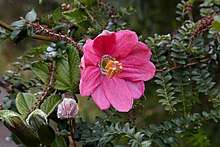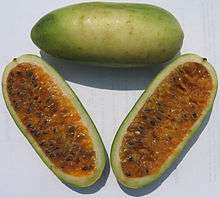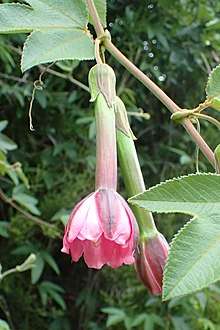Banana passionfruit
Banana passionfruit (Passiflora supersect. Tacsonia) also known as Curuba is a group of around 64 Passiflora species found in South America.[1][2] Most species in this section are found in high elevation cloud forest habitats. Flowers have a cylindrical hypanthium.
| Banana passionfruit | |
|---|---|
 | |
| Passiflora mixta | |
| Scientific classification | |
| Kingdom: | Plantae |
| Clade: | Tracheophytes |
| Clade: | Angiosperms |
| Clade: | Eudicots |
| Clade: | Rosids |
| Order: | Malpighiales |
| Family: | Passifloraceae |
| Genus: | Passiflora |
| Supersection: | Passiflora supersect. Tacsonia (Juss.) Feuillet & J.M.MacDougal (2003) |
| Type species | |
| Passiflora mixta Lam. | |
| Species | |
|
See text | |
| Synonyms | |
Species

Whole and longitudinally-cut banana passionfruits.

Banana Passionfruit Ceramic. Moche Culture. Larco Museum Collection.
| Section | Series | Image | Scientific name | Distribution |
|---|---|---|---|---|
| Bolivianae | Passiflora gracilens | Bolivia( Cochabamba and La Paz), Peru (Apurimac, Cajamarca, Cusco, Huancavelica, Huánuco, Junín, and La Libertad) | ||
| Rathea | Passiflora andina | |||
| Passiflora colombiana | ||||
| Passiflora harlingii | ||||
| Passiflora unipetala | ||||
| Insignes | Passiflora carrascoensis | |||
| Passiflora insignis | ||||
| Passiflora lanceolata | ||||
| Passiflora mandonii | ||||
| Passiflora pilosicorona | ||||
| Passiflora pinnatistipula | ||||
| Tasconiopsis | Passiflora bracteosa | |||
| Passiflora purdiei | ||||
| Trifoliata | .jpg) |
Passiflora trifoliata | ||
| Passiflora huamachucoensis | ||||
| Fimbriatistipula | Passiflora fimbriatistipula | Colombia (Huila and Cauca) | ||
| Passiflora uribei | Colombia (Putumayo) | |||
| Manicata | Passiflora manicata | |||
| Passiflora macropoda | ||||
| Passiflora trisecta | ||||
| Passiflora peduncularis | ||||
| Passiflora weberbaueri | ||||
| Parritana | Passiflora parritae | Colombia (Caldas, Tolima, and Risaralda) | ||
| Passiflora jardinensis | Colombia (Jardín in Antioquia) | |||
| Tacsonia | Passiflora amazonica | |||
| Passiflora mixta | ||||
| Passiflora matthewsii | ||||
| Passiflora schlimiana | ||||
| Passiflora salpoense | ||||
| Colombiana | Quindiensae | Passiflora linearistipula | ||
| Passiflora quindiensis | ||||
| Leptomischae | Passiflora ampullacea | |||
| Passiflora antioquiensis | ||||
| Passiflora coactilis | ||||
| Passiflora cremastantha | ||||
| Passiflora flexipes | ||||
| Passiflora leptomischa | ||||
| Passiflora tenerifensis | ||||
| Colombianae | Passiflora adulterina | |||
| Passiflora crispolanata | ||||
| Passiflora cuatrecasasii | ||||
| Passiflora formosa | ||||
| Passiflora lanata | ||||
| Passiflora pamplonensis | ||||
| Passiflora rugosa | ||||
| Passiflora trianae | ||||
| Passiflora truxillensis | ||||
| Elkhea | Passiflora anastomosans | |||
| Passiflora brachyantha | ||||
| Passiflora cumbalensis | ||||
| Passiflora linearistipula | ||||
| Passiflora jamesonii | ||||
| Passiflora linda | ||||
| Passiflora loxensis | ||||
| Passiflora luzmarina | ||||
| Passiflora roseorum | ||||
| Passiflora sanctae-barbarae | ||||
.jpg) |
Passiflora tarminiana | |||
 |
Passiflora tripartita | |||
| Passiflora zamorana | Ecuador (Zamora-Chinchipe) | |||
Invasive species
P. tarminiana and P. tripartita thrive in the climate of New Zealand. They are invasive species since they can smother forest margins and forest regrowth. It is illegal to sell, cultivate and distribute the plants.[3]
Banana passionfruit vines are now smothering more than 200 square miles (520 km2) of native forest on the islands of Hawaii and Kauai. Seeds are spread by feral pigs, birds and humans.[4][5] The vine can also be found all across the highlands of New Guinea.
gollark: Is there even a model of ethics humans have which doesn't eventually produce terrible results?
gollark: UTCish, 16:00ish to 23:00ish.
gollark: They could at least use 0 AM for midnight and it'd actually be consistent.
gollark: 12-hour time is very silly because 12 AM/PM should be 0.
gollark: It's the correct time system, you utter person.
References
- Ulmer, Torsten (2004). Passiflora : Passionflowers of the world. Portland: Timber Press. ISBN 0-88192-648-5. OCLC 53356535.
- Schoeniger, Gudrun (1986). La curuba : técnicas para el mejoramiento de su cultivo (in Spanish). Bogotá, Colombia: COLCIENCIAS Editora Guadalupe. ISBN 958-608-036-6. OCLC 17106360.
- http://www.biosecurity.govt.nz/pests/banana-passionfruit
- Smith, Clifford W. "Impact of Alien Plants on Hawai'i's Native Biota". University of Hawaii. Archived from the original on 13 July 2011. Retrieved 8 March 2011.
- The University of Georgia - Center for Invasive Species and Ecosystem Health and the National Park Service (17 February 2011). "Invasive Plant Atlas of the United States". Retrieved 8 March 2011.
External links
- Purdue University (United States) - Banana passionfruit

This article is issued from Wikipedia. The text is licensed under Creative Commons - Attribution - Sharealike. Additional terms may apply for the media files.